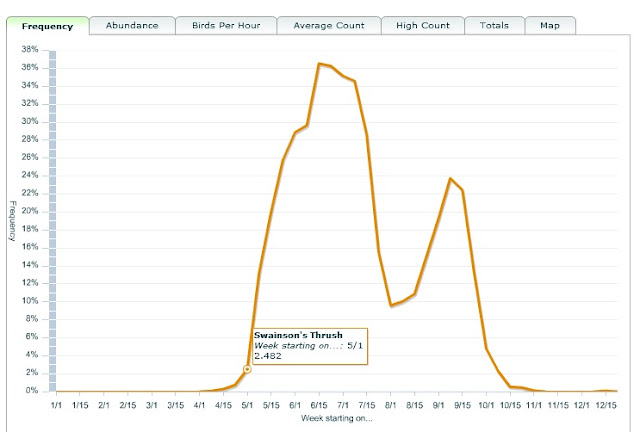There. I said it. It may not be absolutely true, but true enough that if you think you saw one before May you better make doubly sure. In fact, it is possible that many Swainson's Thrushes reported before May 8 are in error, too.
In February I wrote a blog post for Birding is Fun! titled: Ten most-misidentified birds in the Pacific Northwest. The number one identification problem mentioned by a group of knowledgeable birders was the misidentification of Hermit Thrushes as Swainson's Thrushes.
Swainson's Thrushes vacate North America in late fall and do not come back until late spring. Nevertheless, numerous beginning birders every year report Swainson's Thrushes in April and even March. Hermit Thrushes are abundant early spring migrants and winter in good numbers in wooded areas west of the Cascades. Swainson's Thrushes nest in lowlands, Coast Range, and lower mountain slopes with deciduous or mixed woods. Hermit Thrushes in the Pacific NW nest in high elevation evergreen forests from the Cascade crest eastward (also in higher Olympic Mountains of Washington).
Take a look at the photos below. Do you see why many people have trouble telling these apart?
 |
| Swainson's Thrush. 28 June 2008. Timber, Oregon by Greg Gillson. |
 |
| Hermit Thrush. 17 December 2010. Hagg Lake, Oregon by Greg Gillson. |
Hermit Thrushes have slightly darker, rounder breast spots, and a reddish rump. Swainson's Thrushes have a pale supraloral area (the lores is the area between eye and bill, supraloral is above that). It makes the Swainson's Thrush look like it is wearing spectacles. Trouble is, this isn't that distinctive (see above photos). It doesn't help that these birds are shy and hide in the thick, shaded, understory shrubs.
East of the Cascades the subspecies look slightly less similar, but the Swainson's Thrushes east of the Cascades migrate even later in spring than those west of the Cascades.
Calls and songs are different. But Starlings and other birds can imitate the Swainson's Thrush's mellow whistled "whit" call. Hermit Thrushes give a blackbird-like chuck call.
 |
| Swainson's Thrushes reports in eBird for the Willamette Valley of western Oregon. |
Notice the eBird history for Willamette Valley, 1900-2013 (above). Only a very few Swainson's Thrushes show up the first week of May; most arrive later in May. Earlier reports are either exceptionally early birds or (probably) misidentifications.
Let's look at just the last 5 years for all of Oregon.
 |
| eBird graph of Swainson's Thrushes in Oregon, 2008-2012. |
1) The reports in March and early April are probably misidentified. Even if some are correct, they make up less than 1% of checklist frequency. Consider it data "noise."
2) Ignoring the early noise, the first birds for the year didn't arrive until the first week of May in 4 of 5 years. In 2008, perhaps due to weather conditions, Swainson's Thrushes arrived in western Oregon some time during the fourth week of April (April 22-30th; see the label on the above graph).
3) Notice the peak frequencies in the fourth week of May (migration) and the third week of June (territorial singing). Then notice more detections as they migrate south in September and are heard by birders at night as they fly over calling "weet."
4) A single bird with injured wing photographed in Portland in December 2008. Healthy birds are highly unlikely in winter anywhere in North America.
So that's it. Question the correctness of your identification of Swainson's Thrushes before mid-May. Try to really study both these rather common woodland and forest birds this summer and learn their calls, songs, behavior, and habitat. It's always fun to be the first one on your block (I mean, listserv) to report the arrival of a new spring migrant. It's better, though, to actually be correct.